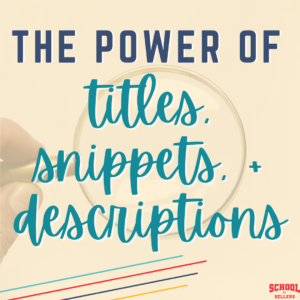Episode #41: Batch Chat + More Teacher Seller Talk with Farrah Henley
I’m very excited about this week’s episode because I’m doing something I’ve never done before — having a guest on the show! This week, I’m chatting with my friend Farrah Henley from Farrah Henley Education. She’s here to give us the 411 all about how what she learned in the Finishing Framework course has changed the trajectory of her business. She also shares an unexpected side effect of batching and having more free time!
About My Guest: Farrah Henley
Farrah is a multi-passionate entrepreneur and brings 25 years of experience as an educator to her business. She started her TeachersPayTeachers store in 2011. Like many of us, she started out just creating resources for her own classroom, and she used the money she made to develop a 1:1 device program! She also previously taught with VIPKid and now lives in her RV full-time with her husband and pets.
What’s something that helped your business take off?
Farrah: I think it’s mostly the way that I serve my audience, the way that I interact and get to know them, and the fact that I’m everywhere and have different audiences on different platforms. Also, Facebook ads really helped my store take off. With the ads, I’ve been able to create a multi-6 figure business on the back of five products.
Erin: I’ve noticed that there is a similar trajectory for TpT sellers. There is a lot of product creation at first, and then at some point you have to shift the way you work so you can reach that next level of business.
Farrah: Yes! And I also noticed that when the business started taking off, my best-selling products were the ones I liked making the least. That makes sense because you want to fill a need. Do what you have to do to start, and that will free you up to do what you’re passionate about later.
Why We Love Batching
Erin: I want to talk about batching. My own batching obsession actually started with product creation and wanting to just get things done. But then once I realized how productive I was being with that, my wheels started turning. How can I put this practice into effect in all the other areas of my business?
Erin: And just so we’re all on the same page, when we talk about batching, we mean attacking similar tasks in one sitting rather than having them on your to do list every single day. For example, creating social media posts. Instead of posting every single day, you create a week or two or even longer worth of posts in one sitting and schedule them out. So why do you love batching, Farrah?
Farrah: I never got the hang of batching with products. Looking back, I wish I had. I know I would have knocked out way more products if I had been batching. With a team though, because of what I learned about batching in your course, I’m able to pass that on to the team. So the team batches, which is really nice. In our curriculum team, no one person is on one project and all of the pieces. They’re batching pieces of individual products because they are responsible for that piece. One person might be responsible for making the printable version, and another will make the digital.
Where I’ve put batching into practice the most is with regard to my marketing and how I can show up for my audience. Because it is very hard to be … there’s only so many hours in the day. And it’s very hard to be everywhere. But I do believe you need to be everywhere to have the biggest impact. You have teachers who only use Pinterest, others where Instagram is their jam, some who only have Facebook… and then there’s YouTube, and now Clubhouse. It’s a lot!
The Power of Workcations
Erin: Now let’s talk about workcations. I know this is something you’ve really come to appreciate. (If you don’t know what a workcation is, you should go and listen to Episode 16, all about the teacher seller hack you’ve been missing in your life.)
Farrah: YES! I like to take 2-4 days a quarter and batch my content for the entire quarter. That means I can now be everywhere. You get distracted at home. There’s kids, pets, significant others. Being able to take a few days to sit and batch content means that I don’t have to worry about when I’m videoing or coordinating schedules with other people. It’s mind blowing to get a quarter’s worth of video done in 4 days. It’s not easy, but the tradeoff is remarkable. Keep in mind it’s a growth process though. You learn to tweak things as you go. For my next session, I’m only recording one piece of content, but I’m going to repurpose it into a bunch of different things.
The Finishing Framework:
Who is it right for?
Erin: Let’s talk about the Finishing Framework more specifically. I think one thing that’s really cool to see as more and more people go through the course is how flexible the framework really is. You can do it all yourself, or you can hire out certain pieces. You can batch all at once, or you can batch in pieces. It works for so many different situations.
Farrah: Absolutely. If I would’ve had the Framework in 2011…even as a solopreneur for so many years…maybe I wouldn’t have been able to do it right off the bat, but I could see taking this piece and getting this piece down and then adding another one and another one. If you’re a solopreneur and you’re not in the classroom, then it’s totally doable. Every piece of the framework is doable for a solopreneur.
I feel like it can really help any part of your TpT journey, whether you’re just starting out or not. Any level, solopreneur all the way up to someone with a team. You can take the pieces and you can be like this piece pertains to you or it all pertains to me. It’s totally doable. Part of the success I had with it is I just said, “I’m going in!” Don’t think about it, just dive. Dive in head first! I remember the first workcation. I did 12 blog posts, 12 YouTube videos, and 12 podcasts.
“Part of the success I had with [the Finishing Framework course] is I just said, ‘I’m going in!’ Don’t think about it, just dive. Dive in head first!”
Erin: And you even managed to show up to the office hours at the same time! That’s the beauty of it though, and the learning as you go. The first time I launched the course, I was almost afraid to show other people the checklist because it’s so long. But honestly the more you do it, the easier it gets. You get faster and just kind of find your own rhythm.
So many think they know what batching is because we hear about it everywhere, but I’ve had a lot of people say, “Well I thought I was batching, but after the course, I realized I needed to tweak some things.”
What would you tell someone who is on the fence about either the course or batching in general?
Farrah: Batching does not have to mean from start to finish. In the first workcation, I went in thinking I would have all 12 things done from start to finish and that I could go home and not have to do anything for the next 3 months. I got a ton done during those three days, but I hadn’t gotten everything done from start to finish. But what I HAD gotten done was so much of the work and the foundational aspects. The leftover stuff was just the polishing pieces.
My blog batching now is just doing the research for the posts and then I hand them off to someone else. I do the beginning stages and get a plan for the entire quarter, do potential featured images, plan opt-ins, etc., and then I pass it off to my blog coordinator.
Erin: I love that point. I feel like a lot of people probably have that idea of batching. Batching can mean whatever it means to you, and it can be applied in many different ways. But batching piece by piece allows you to get in a certain zone of genius for one sitting. If you’re feeling creative, sit and batch the plans and the overview. And then for your next session, you can do the image batching or whatever else. The important part is that you’re not stringing yourself along, burning yourself out.
Farrah: Exactly. For my second batching session, I had a plan. And things went a lot more smoothly. Now I’m adding in the repurposing piece too. One of the things you teach in the course is your image batching. I can use those images on multiple platforms and I don’t have to make 5 different images for 5 pieces of content. Use the one piece in multiple places.
You don’t have to do it from start to finish, but take the pieces that take the longest amounts of time and do them all at once. If you don’t have a team, that’s perfectly fine. You just press pause and continue and batch the next section. Batching schedules can be different, especially if you’re in the classroom. You might have to batch one piece one weekend and then batch your next piece the next weekend.
Erin: I’m sure there are people listening who think this sounds great, but they’re still in the classroom. In the Finishing Framework course, I explain it like this. You can get into bulldozer mode and go straight through for as long as you want, maybe during a workcation if that’s your thing. Or you might have to do it in smaller increments. Maybe you’re just doing power hours. Literally on the weekend, set aside an hour and go through the batching framework and see how much you can batch in this amount of time. Not “let’s see if I can finish all of my stuff in this amount of time,” but “let’s see how much I can batch.”
The Unexpected Side Effect of Batching
Farrah: Now that I’ve been batching for a while, I realized something. We fall into a trap of when you start doing this, because your time is freed up and you’re not constantly working on something, and you only have a few things on your to do list each day, you start to wonder how it’s possible. You start to second guess that you’ve missed something, and that will be a part of the process. You’re not used to having time. You’re not used to having free time to not be working constantly.
Erin: We’ve actually added another system to the course to make sure your regular tasks aren’t falling by the wayside. Because that’s a very real feeling when you think, “There has to be something I’m missing.”
Farrah: Getting to a point where I know I don’t have to worry about content going out every week is so nice. Start small though. Don’t do it like I did. I was not in the classroom, I had all the time in the world to do it, I don’t have kids. I’m definitely in a different situation, so don’t think that you have to do so much at once. My success didn’t come from bulldozer batching. It’s not a magic pill. But it will teach you to better organize your time so you’re not doing what I was doing, which was working from 6 AM to 2 AM seven days a week.
Erin: I was a total hustler at the very beginning. I think some of those nights are inevitable, but you just realize what’s possible. I even find that these mindsets trickle into my personal life too. Like now we even batch our laundry.
Farrah: It’s just amazing what kinds of things you put into practice when you know how you spend your time. It will start filtering over into other parts of your life. Those days where you work 18 hours, I still have those sometimes. But now it’s because I want to. I’m learning new things, exploring new passions, etc. I never feel like I can’t shut it off if I wanted to. And I take more naps. When your to do list isn’t attached to a deadline every time because you’ve already met the deadline, it’s an amazing feeling. Like oh I don’t actually have to do that right now. I want to work ahead, but I don’t have to.
Run Your Business Instead of Letting Your Business Run You
Farrah: When you were first launching the course, you said something that resonated with me. You said working IS your self-care. I enjoy my business just like you. So I don’t feel like working as much as I do is a bad thing. Until I get to the point where I have to work like that. At that point, I’m no longer running my business, my business is running me. I want me to be running my business. So if I want to work 18 hours a day, I can. But only because I want to. It’s a different experience when you’re doing it out of passion and not obligation.
Thank you so much to Farrah Henley for joining me this week. One more time, here is a link to check out the Finishing Framework and what it can do for your business.
Links mentioned in this episode:
Looking for another way to get this episode? Download the transcript here!

Subscribe to the show!
Are you subscribed to the School of Sellers podcast yet? If not, I want to encourage you to do that today so you never miss an episode. Subscribe on Spotify, Apple Podcasts, Stitcher, Amazon Music, or Google Podcasts!
If you’re feeling generous, I would be eternally grateful if you left me a review over on Apple Podcasts, too. Reviews help other sellers find my podcast just like you. Thank you!
Let’s connect!
Follow us on the podcast, the Facebook group for new sellers, the Facebook group for established sellers, YouTube, Instagram, and TikTok!





